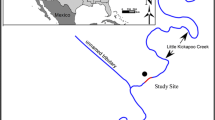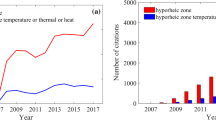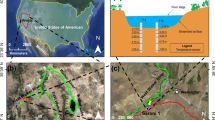Abstract
It is challenging to quantify reach-scale surface-water–groundwater interactions, while maintaining the fine-scale spatial resolution required in hyporheic studies. One-dimensional heat-transport modeling was used to simulate streambed fluxes at discrete points using time-series temperature records. A predictive relationship was then developed between point-in-time streambed temperature and modeled flux rates. Flux was mapped at high spatial resolution by applying the predictive relationship to mapped streambed temperatures, which allowed for high-resolution quantification of flux by proxy. Inferred patterns of flux are consistent with morphology and yielded a net flux to a 30-m stream reach of 1.0 L s–1. Discharge of saline groundwater (5.7 g L–1 Cl–) allowed for comparison between the temperature proxy method and geochemical variability. Maximum upwelling locations (>35 cm day–1) were spatially coincident with areas of high conductance at the bed interface (5–25 mS cm–1). Differences between gross flux estimates from heat and geochemical methods are attributed to differences in the spatial extent over which estimates were derived and limited sensitivity of the temperature-as-proxy method. When bed temperatures are near their inherent limits (groundwater and stream-water temperatures) the flux magnitude can be underestimated. Caution must be used when determining gross, reach-scale fluxes from temperature-as-proxy methods when flux rates are outside the sensitivity limits.
Résumé
C’est un défi de quantifier à l’échelle du bief les interactions eau de nappe-eau de surface, tout en conservant la résolution spatiale à la petite échelle nécessaires aux études hyporhéiques. Une modélisation unidimensionnelle du transport de chaleur a été utilisée pour simuler les flux d’écoulement entre des points distincts en utilisant des enregistrements temporels de la température. Une relation prévisionnelle a été développée entre la température instantanée du lit et les flux modélisés. Le flux a été cartographié en haute résolution spatiale en appliquant la relation prévisionnelle aux températures du lit cartographiées, ce qui a permis une quantification haute résolution du flux par marqueur. Les caractéristiques du flux déduites sont conformes à la morphologie et fournissent sur un bief de 30-m un flux net de 1.0 L s–1. La décharge d’eau de nappe saline (5.7 g L–1 Cl–) a permis la comparaison entre la méthode de marqueur température et la variabilité géochimique. Les emplacements de remontée maximum (>35 cm jour–1) coïncident dans l’espace avec les zones de conductance élevée à l’interface des couches (5–25 mS cm–1). Les différences entre les estimations de flux brut par les méthodes de température et géochimiques sont attribuées à l’échelle spatiale des estimations et à la sensibilité limitée de la méthode des températures en tant que marqueur. Quand les températures sont proche de leurs limites respectives (eau de nappe et eau s’écoulement), l’intensité du flux peut être sous estimée. La prudence s’impose quand on évalue les flux brut à l’échelle du bief à partir de méthodes basées sur la température en tant marqueur quand les flux sont hors limites de sensibilité.
Resumen
Es un desafío cuantificar el alcance de la escala de las interacciones entre el agua superficial y el agua subterránea, mientras se mantiene en la escala fina la resolución espacial requerida en los estudios hiporreicos. Se usó un modelo unidimensional de transporte de calor para simular los flujos de la corriente del lecho del río en puntos discretos usando series temporales de registros de temperaturas. Se desarrolló entonces una relación predictiva entre la temperatura de la corriente del lecho punto a punto en el tiempo y los ritmos modelados del flujo. El flujo fue mapeado con una alta resolución espacial aplicando la relación predictiva para el mapeado de las temperaturas de la corriente del lecho, las cuales permitieron una cuantificación de alta resolución del flujo para la representación. Los esquemas inferidos de flujo son consistentes con la morfología y brindaron un flujo neto para un tramo de la corriente de 30-m de 1.0 L s–1. La descarga de agua subterránea salina (5.7 g L–1 Cl–) permitió por comparación entre el método de la representación de la temperatura y la variabilidad geoquímica. Los puntos de las máximas surgencias (>35 cm day–1) fueron espacialmente coincidentes con las área de alta conductancia en la interfase del lecho (5–25 mS cm–1). Las diferencias entre la estimación gruesa del flujo a partir de métodos calóricos y geoquímicos son atribuidos a diferencias en la extensión espacial sobre la cual las estimaciones fueron deducidas y a los límites de sensibilidad de la temperatura como el método de representación de la temperatura. Cuando las temperaturas del lecho están cercanas a sus límites inherentes (temperaturas del agua subterránea y de la corriente) la magnitud del flujo puede ser subestimada. Se debe tener cuidado cuando se determinan los alcances del flujo a una escala gruesa a partir métodos de representación por temperatura cuando los ritmos de flujo están fuera de los límites de sensibilidad.
摘要
在保持交错带研究中精细尺度的空间分辨率的前提下定量化确定河段尺度地表水和地下水相互作用具有挑战性。利用温度随时间变化的序列,利用一维热运移模型模拟在不同离散点的河床流。建立了不同时间点间的河床温度和模拟流速间的预测性关系。通过把预测性关系应用到河床温度上,把流量投影到高空间分辨率的图上,这考虑到通过代替的流量的高分辨率定量化。流量的推断模式和形态是一致的,并得到一条30 m的河流的净流量为1 L/s。地下咸水(5.7 g L–1 Cl–) 排泄考虑到温度替代方法和地球化学变化性的对比。最大涌水点(>35 cm day–1)在空间上与层界面处高电导区域(5–25 mS cm–1)相吻合。用热示踪方法和地球化学方法评估得到的总流量的不同是因为空间范围的不同,评估结果源自选定的空间范围,并且对温度替代方法的敏感性是有限的。当河床温度接近它内在的极限时(地下水和河水温度)流量的数值可能被低估。当流速在灵敏限外时,利用温度替代方法评估河段尺度的总流量时应谨慎。
Resumo
É desafiador quantificar as interações água superficial-água subterrânea à escala da linha de água, mantendo a resolução espacial de pequena escala necessária nos estudos hiporreicos. A modelação unidimensional de transporte de calor foi usada para simular fluxos em sedimentos do leito em pontos discretizados, usando séries temporais de registo da temperatura. Seguidamente, foi desenvolvida uma relação de predição entre a temperatura do sedimento do leito no ponto e no tempo e as taxas de fluxo modeladas. O fluxo foi mapeado com uma resolução espacial elevada, através da aplicação da relação de predição às temperaturas mapeadas do sedimento do leito, o que permitiu quantificar o fluxo através desse indicador, com elevada resolução. Os padrões de fluxo inferidos são compatíveis com a morfologia e conduzem a um fluxo bruto para um comprimento de linha de água de 30 m de 1.0 L s–1. A descarga de água subterrânea salina (5.7 g L–1 Cl–) permitiu a comparação entre o método indicador da temperatura e a variabilidade geoquímica. Os locais de máximo fluxo ascendente (>35 cm dia–1) coincidem com as áreas de elevada condutância na interface do leito (5–25 mS cm–1). As diferenças entre as estimativas do fluxo bruto a partir de métodos de calor e a partir de métodos geoquímicos são atribuídas às diferenças na extensão espacial a partir da qual se efetuaram as estimativas e também devido à limitada sensibilidade do método indicador de temperatura. Quando as temperaturas do leito estão próximas dos seus limites inerentes (as temperaturas da água subterrânea e da linha de água), a magnitude do fluxo pode ser subestimada. Devem ser tomadas precauções quando se determinam os fluxos brutos à escala da linha de água a partir de métodos indicadores de temperatura quando as taxas de fluxo estão fora dos limites de sensibilidade.









Similar content being viewed by others
References
Anderson MP (2005) Heat as a ground water tracer. Ground Water 43:951–968
Anibas C, Fleckenstein JH, Volze N, Buis K, Verhoeven R, Meire P, Batelaan O (2009) Transient or steady-state? Using vertical temperature profiles to quantify groundwater–surface water exchange. Hydrol Proc 23:2165–2177. doi:10.1002/Hyp.7289
Anibas C, Buis K, Verhoeven R, Meire P, Batelaan O (2011) A simple thermal mapping method for seasonal spatial patterns of groundwater–surface water interaction. J Hydrol 397:93–104. doi:10.1016/J.Jhydrol.2010.11.036
Becker MW, Georgian T, Ambrose H, Siniscalchi J, Fredrick K (2004) Estimating flow and flux of ground water discharge using water temperature and velocity. J Hydrol 296:221–233
Boano F, Revelli R, Ridolfi L (2009) Quantifying the impact of groundwater discharge on the surface-subsurface exchange. Hydrol Proc 23:2108–2116. doi:10.1002/Hyp.7278
Briggs MA, Lautz LK, McKenzie JM (2012a) A comparison of fibre-optic distributed temperature sensing to traditional methods of evaluating groundwater inflow to streams. Hydrol Proc 26:1277–1290. doi:10.1002/hyp.8200
Briggs MA, Lautz LK, McKenzie JM, Gordon RP, Hare D (2012b) Using high-resolution distributed temperature sensing to quantify spatial and temporal variability in vertical hyporheic flux. Water Resour Res 48:W02527. doi:10.1029/2011WR011227
Cardenas MB (2010) Thermal skin effect of pipes in streambeds and its implications on groundwater flux estimation using diurnal temperature signals. Water Resour Res 46:W03536. doi:10.1029/2009WR008528
Cardenas MB, Wilson JL (2006) The influence of ambient groundwater discharge on exchange zones induced by current-bedform interactions. J Hydrol 331:103–109
Conant B (2004) Delineating and quantifying ground water discharge zones using streambed temperatures. Ground Water 42:243–257
Conant B, Jr. (2000) Ground-water plume behavior near the ground-water/surface water interface of a river. Proceedings of the Ground-Water/Surface-Water Interactions Workshop EPA/542/R-00/007, Denver, CO, July 2000, pp 23–30
Constantz J (2008) Heat as a tracer to determine streambed water exchanges. Water Resour Res 44:W00D10. doi:10.1029/2008wr006996
Covino TP, McGlynn BL (2007) Stream gains and losses across a mountain-to-valley transition: mpacts on watershed hydrology and stream water chemistry. Water Resour Res 43:W10431. doi:10.1029/2006wr005544
Department of Environmental Conservation (DEC) New York State (2003) Geddes Brook /Ninemile Creek remedial investigation report. DEC, Albany, NY
Evans EC, Petts GE (1997) Hyporheic temperature patterns within riffles. Hydrol Sci J 42:199–213
Ferguson G, Bense V (2011) Uncertainty in 1D heat-flow analysis to estimate groundwater discharge to a stream. Ground Water 49:336–347. doi:10.1111/J.1745-6584.2010.00735.X
Fleckenstein JH, Krause S, Hannah DM, Boano F (2010) Groundwater-surface water interactions: new methods and models to improve understanding of processes and dynamics. Adv Water Resour 33:1291–1295. doi:10.1016/J.Advwatres.2010.09.011
Fritz BG, Arntzen EV (2007) Effect of rapidly changing river stage on uranium flux through the hyporheic zone. Ground Water 45:753–760
Gordon RP, Lautz LK, Briggs MA, McKenzie JM (2012) Automated calculation of vertical pore-water flux from field temperature time series using the VFLUX method and computer program. J Hydrol 420–421:142–158
Goto S, Yamano M, Kinoshita M (2005) Thermal response of sediment with vertical fluid flow to periodic temperature variation at the surface. J Geophys Res B: Solid Earth 110:B01106. doi:10.1029/2004JB003419
Harvey JW, Bencala KE (1993) The effect of streambed topography on surface-subsurface water exchange in mountain catchments. Water Resour Res 29:89–98
Hatch CE, Fisher AT, Revenaugh JS, Constantz J, Ruehl C (2006) Quantifying surface water-groundwater interactions using time series analysis of streambed thermal records: method development. Water Resour Res 42:W10410. doi:10.1029/2005WR004787
Hayashi M, Rosenberry DO (2002) Effects of ground water exchange on the hydrology and ecology of surface water. Ground Water 40:309–316
Healy RW, Ronan AD (1996) Documentation of computer program VS2DH for simulation of energy transport in variably saturated porous media: modification of the US Geological Survey’s computer program VS2DT. US Geol Surv Water Resour Invest Rep 96–4230, 36 pp
Hsieh PA, Wingle W, Healy RW (2000) VS2DI: a graphical software package for simulating fluid flow and solute or energy transport in variably saturated porous media. U S Geological Survey, Reston, VA
Hubbart J, Link T, Campbell C, Cobos D (2005) Evaluation of a low-cost temperature measurement system for environmental applications. Hydrol Proc 19:1517–1523
Kalbus E, Reinstorf F, Schirmer M (2006) Measuring methods for groundwater-surface water interactions: a review. Hydrol Earth Syst Sci 10:873–887
Kasahara T, Wondzell SM (2003) Geomorphic controls on hyporheic exchange flow in mountain streams. Water Resour Res 39:1005. doi:10.1029/2002WR001386
Keery J, Binley A, Crook N, Smith JWN (2007) Temporal and spatial variability of groundwater–surface water fluxes: development and application of an analytical method using temperature time series. J Hydrol 336:1–16
Krause S, Hannah DM, Blume T (2011) Interstitial pore-water temperature dynamics across a pool-riffle-pool sequence. Ecohydrol 4:549–563. doi:10.1002/Eco.199
Land M, Ingri J, Andersson PS, Ohlander B (2000) Ba/Sr, Ca/Sr and Sr-87/Sr-86 ratios in soil water and groundwater: implications for relative contributions to stream water discharge. Appl Geochem 15:311–325
Landmeyer JE, Bradley PM, Trego DA, Hale KG, I Haas JE (2010) MTBE, TBA, and TAME attenuation in diverse hyporheic zones. Ground Water 48:30–41
Lapham WW (1989) Use of temperature profiles beneath streams to determine rates of vertical ground-water flow and vertical hydraulic conductivity. US Geol Surv Water Suppl Pap 2337
Lautz LK (2010) Impacts of non-ideal field conditions on vertical water velocity estimates from streambed temperature time series. Water Resour Res 46:W01509
Lautz LK, Fanelli RM (2008) Seasonal biogeochemical hotspots in the streambed around restoration structures. Biogeochemistry 91:85–104
Lewandowski J, Angermann L, Nützmann G, Fleckenstein JH (2011) A heat pulse technique for the determination of small-scale flow directions and flow velocities in the streambed of sand-bed streams. Hydrol Proc 25:3244–3255. doi:10.1002/hyp.8062
Lizlovs S (2005) Industrial waste contamination: past, present, and future. Clearwaters, New York, pp 25–29
Loheide SP, Gorelick SM (2006) Quantifying stream-aquifer interactions through the analysis of remotely sensed thermographic profiles and in situ temperature histories. Environ Sci Technol 40:3336–3341
Lowry CS, Walker JF, Hunt RJ, Anderson MP (2007) Identifying spatial variability of groundwater discharge in a wetland stream using a distributed temperature sensor. Water Resour Res 43:W10408. doi:10.1029/2007wr006145
Matthews DA, Effler SW (2003) Decreases in pollutant loading from residual soda ash production waste. Water Air Soil Pollut 146:55–73
Panno SV, Hackley KC, Hwang HH, Greenberg SE, Krapac IG, Landsberger S, O'Kelly DJ (2006) Characterization and identification of Na–Cl sources in ground water. Ground Water 44:176–187
Payn RA, Gooseff MN, McGlynn BL, Bencala KE, Wondzell SM (2009) Channel water balance and exchange with subsurface flow along a mountain headwater stream in Montana United States. Water Resour Res 45:W11427. doi:10.1029/2008wr007644
Pinder GF, Jones JF (1969) Determination of the ground-water component of peak discharge from the chemistry of total runoff. Water Resour Res 5:438–445
Rau GC, Anderson MS, McCallum AM, Acworth RI (2010) Analytical methods that use natural heat as a tracer to quantify surface water–groundwater exchange, evaluated using field temperature records. Hydrogeol J 18:1093–1110
Rau GC, Andersen MS, Acworth RI (2012) Experimental investigation of the thermal dispersivity term and its significance in the heat transport equation for flow in sediments. Water Resour Res 48:W03511. doi:10.1029/2011WR011038
Schmidt C, Brewster Conant J, Bayer-Raich M, Schirmer M (2007) Evaluation and field scale application of an analytical method to quantify groundwater discharge using mapped streambed temperatures. J Hydrol 347:292–307
Selker JS, Thevenaz L, Huwald H, Mallet A, Luxemburg W, de Giesen NV, Stejskal M, Zeman J, Westhoff M, Parlange MB (2006) Distributed fiber-optic temperature sensing for hydrologic systems. Water Resour Res 42:W12202, 8 pp
Shanafield M, Hatch C, Pohll G (2011) Uncertainty in thermal time series analysis estimates of streambed water flux. Water Resour Res 47:W03504. doi:10.1029/2010wr009574
Sophocleous M (2002) Interactions between groundwater and surface water: the state of the science. Hydrogeol J 10:52–67
Stallman RW (1965) Steady one-dimensional fluid flow in a semi-infinite porous medium with sinusoidal surface temperature. J Geophys Res 70:2821–2827
Stonestrom DA, Constantz J (2004) Heat as a tool for studying the movement of ground water near streams. US Geol Surv Circ 1260
Suzuki S (1960) Percolation measurements based on heat flow through soil with special reference to paddy fields. J Geophys Res 65:2883–2885
Swanson TE, Cardenas MB (2010) Diel heat transport within the hyporheic zone of a pool-riffle-pool sequence of a losing stream and evaluation of models for fluid flux estimation using heat. Limnol Oceanogr 55:1741–1754
Taylor CJ, Pedregal DJ, Young PC, Tych W (2007) Environmental time series analysis and forecasting with the Captain toolbox. Environ Model Softw 22:797–814
Vogt T, Schneider P, Hahn-Woernle L, Cirpka OA (2010) Estimation of seepage rates in a losing stream by means of fiber-optic high-resolution vertical temperature profiling. J Hydrol 380:154–164. doi:10.1016/J.Jhydrol.2009.10.033
Westhoff MC, Savenije HHG, Luxemburg WMJ, Stelling GS, van de Giesen NC, Selker JS, Pfister L, Uhlenbrook S (2007) A distributed stream temperature model using high resolution temperature observations. Hydrol Earth Syst Sci 11:1469–1480
Winter TC, Rosenberry DO, Sturrock AM (1995) Evaluation of 11 equations for determining evaporation for a small lake in the north central United States. Water Resour Res 31:983–993
Wondzell SM (2006) Effect of morphology and discharge on hyporheic exchange flows in two small streams in the Cascade Mountains of Oregon, USA. Hydrol Proc 20:267–287. doi:10.1002/Hyp.5902
Yager RM, Kappel WM, Plummer LN (2007) Origin of halite brine in the Onondaga Trough near Syracuse, New York state, USA: modeling geochemistry and variable-density flow. Hydrogeol J 15:1321–1339. doi:10.1007/S10040-007-0186-9
Young PC, Pedregal DJ, Tych W (1999) Dynamic harmonic regression. J Forcasting 18:369–394
Young PC, Taylor CJ, Tych W, Pedregal DJ (2007) The Captain Toolbox Centre for Research on Environmental Systems and Statistics, Lancaster, UK, http://www.es.lancs.ac.uk/cres/captain. November 2011
Acknowledegments
We thank Honeywell, Inc. and Al LaBuz for access to the field site and groundwater monitoring wells. We specifically acknowledge Jim Mastroianni, Lisa Kurian, Nate Kranes and Guy Swenson for help with field work and site access. The manuscript benefited from the constructive and detailed comments provided by the associated editor, anonymous reviewers and Christine Hatch. This material is based upon work supported by the National Science Foundation under Grant No. EAR-0901480. Any opinions, findings, and conclusions or recommendations expressed in this material are those of the author(s) and do not necessarily reflect the views of the National Science Foundation.
Author information
Authors and Affiliations
Corresponding author
Rights and permissions
About this article
Cite this article
Lautz, L.K., Ribaudo, R.E. Scaling up point-in-space heat tracing of seepage flux using bed temperatures as a quantitative proxy. Hydrogeol J 20, 1223–1238 (2012). https://doi.org/10.1007/s10040-012-0870-2
Received:
Accepted:
Published:
Issue Date:
DOI: https://doi.org/10.1007/s10040-012-0870-2




